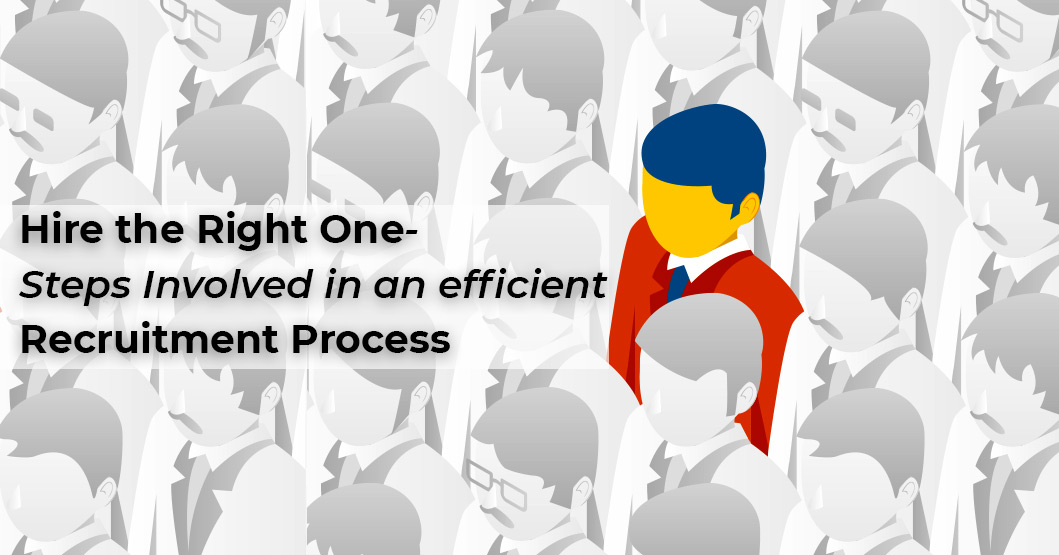This website uses cookies so that we can provide you with the best user experience possible. Cookie information is stored in your browser and performs functions such as recognising you when you return to our website and helping our team to understand which sections of the website you find most interesting and useful.
Hire the Right One- Steps Involved in an efficient Recruitment Process

How Does RPO Add Value To Your Business?
October 30, 2021
It’s the time to take a turn: Benefits of Contract staffing for employees
November 24, 2021The goal of a recruitment process is to select applicants that can best fulfil the job requirements. It is a delicate balance of understanding how to attract and validate candidates, as well as knowing when to let go of those that don’t meet the bar. Recruiting is a difficult process that can take up a lot of valuable time for employers and job candidates alike. But a good hiring process helps minimize the risk of hiring the wrong person by directing applicants through a series of steps that allow you to gather information about their skills, culture fit, and overall abilities for the job. It is usually done in 3 main phases:
#1.Job description and job posting
If you are looking for a new employee, then the first thing that you should do is create a job description. This is a formal list of functions and responsibilities, as well as the qualifications required for the position. Most companies have a standard form that all job descriptions are based on. This form includes information such as job title and duties and responsibilities. However, it’s important to remember that your job description will be unique to your company and the position that you are recruiting. There are many different types of job descriptions out there, and no universal template can be used. Job descriptions have to be tailored to the specific role you’re hiring for, and that means that they don’t really have a “standard” format.
The second step is to post it on various platforms, where your potential candidates may find it. This can be social media platforms like Facebook and LinkedIn or some job posting sites that can give maximum reach for your job posting. Some companies have their own job portal through which they post the current open positions for which they want to hire suitable candidates.
#2.Pre-screening and screening of applicants
Companies are using various techniques for recruiting and screening applicants in a recruitment process. So, what exactly are pre-screening and screening? Pre-screening involves using technology to filter candidates before they apply. Screening involves using technology and/or human resources to review and rank candidates before you make the hiring decision and offer a job. The first step in this section is to create an applicant pool that is to be screened. This can be done in different ways, manually or by using digital means. Use parameters such as skills, experience, previous company etc to eliminate candidates and filter the right one. Another option is to have a pre-screening interview, preferably via phone or web. The pre-screening interview is usually the first round of interviews that all candidates must go through and can last anywhere from 15 to 30 minutes.
#3.Scheduling interviews with potential candidates

Interview scheduling can be a tedious and time-consuming task for recruiters. However, it is imperative that they do not neglect this step in the recruitment cycle. A recruiter must plan ahead and schedule interviews with potential candidates before they can actually conduct them. All recruiters and hiring managers should be aware of the importance of interview scheduling and how it can greatly help them save time and money. Recruiting activities are expensive for any company. As such, it is important that you spend your time wisely during your search for new employees. For companies, interviews are a way of determining whether or not a candidate is worth the time and money to bring in. There are many different types of interviews, each designed with a specific purpose. A job interview will usually last somewhere between 30 minutes and an hour. In order to get the best candidate for a job, the interviewer needs to be well prepared. Preparing for an interview starts with creating a full list of questions that need to be answered before making an offer. To make the process easier, consider using these methods to interview a candidate:
Do background research about the candidate- use mediums such as LinkedIn for doing it and ask questions based on the findings.
Ask open-ended questions – make sure you ask open-ended questions that reveal how a candidate thinks and what they want from your company.
Ask behavioural questions – instead of asking a candidate about their previous experience, ask them about how they handled a particular situation in past jobs.
Reference checks – do not skip the references given by the candidate. Go through them and verify the details given by the person.
Finally, find the right candidate and appointment them in your office!
Too busy to go through the recruitment process? Call Panacea! Panacea is a professional contract staffing agency who also provides recruitment process outsourcing services. This contract staffing agency will find the right talents that fit your job position and the organization. The experienced and professional team of Panacea will make sure the employees we provide are of great talent and skill so that your business can grow in a fast phase!





